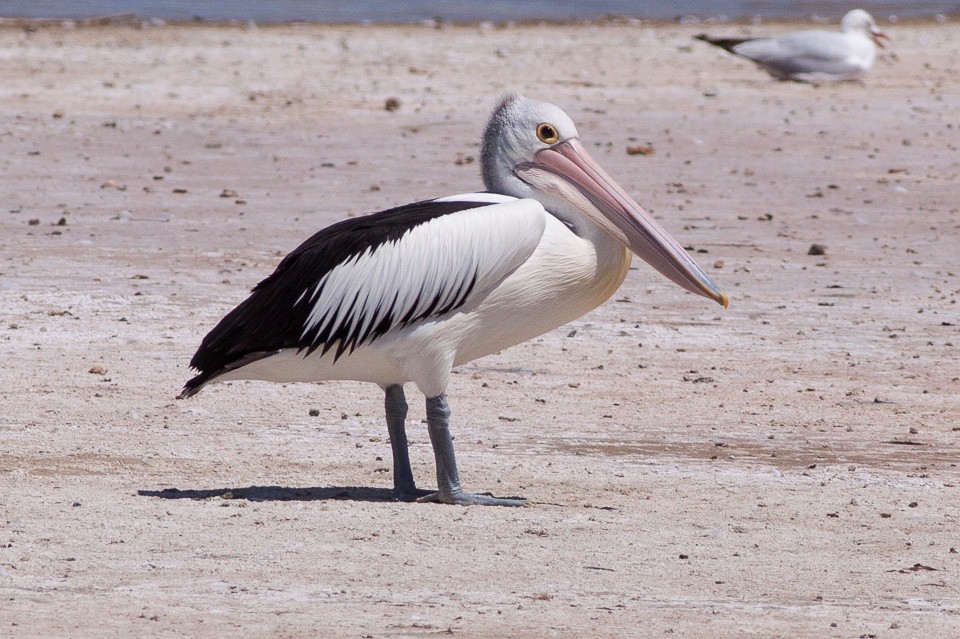Australian Pelican
A species of Pelicans Scientific name : Pelecanus conspicillatus Genus : Pelicans
Australian Pelican, A species of Pelicans
Botanical name: Pelecanus conspicillatus
Genus: Pelicans
Content
Description People often ask General Info
Description
The Australian pelican is medium-sized by pelican standards, with a wingspan of 2.3 to 2.6 m (7.5 to 8.5 ft). Weight can range from 4 to 13 kg (8.8 to 28.7 lb), although most of these pelicans weigh between 4.54 and 7.7 kg (10.0 and 17.0 lb). The average weight of four unsexed Australian pelicans was 5.5 kg (12 lb), making this the heaviest Australian flying bird species on average, although the male of the more sexually dimorphic Australian bustard weighs a bit more at average and maximum weights (both birds are, of course, much smaller than the cassowary and emu). The pale, pinkish bill is enormous, even by pelican standards, and is the largest bill in the avian world. The record-sized bill was 50 cm (20 in) long. Females are slightly smaller with a notably smaller bill, which can measure as small as 34.6 cm (13.6 in) at maturity. The total length is boosted by the bill to 152–188 cm (60–74 in), which makes it rank alongside the Dalmatian pelican as the longest of pelicans. It has the largest bill of any bird. Overall, the Australian pelican is predominantly white in colour. There is a white panel on the upper-wing and a white-V on the rump set against black along the primaries. During courtship, the orbital skin and distal quarter of the bill are orange-coloured with the pouch variously turning dark blue, pink and scarlet. The non-breeding adult has its bill and eye-ring a pale yellow and the pouch is a pale pinkish. Juvenile birds are similar to the adults, but with black replaced with brown and the white patch on upper wing reduced. Overall, their appearance is somewhat similar to several other pelicans, though the species is allopatric. 
Size
150-188 cm (59-74 in)
Colors
Black
White
Life Expectancy
15-50 years
Nest Placement
Ground
Feeding Habits
Australian Pelican primarily consume fish, including introduced species and native perch, employing group foraging to drive prey into shallows before catching with sensitive bills. They exhibit dietary diversity, eating insects, crustaceans, other birds, and occasionally reptiles, amphibians, and anomalously, small dogs. Australian Pelican also display kleptoparasitic behaviors and rare cannibalism.
Habitat
Australian Pelican inhabit diverse aquatic habitats, primarily favoring broad expanses of open water including lakes, estuaries, and coastal lagoons. Versatile in their preferences, they adapt to environments ranging from forests to urban areas, provided food is abundant and human disturbance is minimal. Their nomadic tendencies conform to the availability of food and specific environmental conditions.
Dite type
Piscivorous
People often ask
General Info
Feeding Habits
Bird food type
Distribution Area
This species can occur in large expanses of mainland Australia and Tasmania. Australian pelicans occur primarily in large expanses of open water without dense aquatic vegetation. The habitats that can support them include large lakes, reservoirs, billabongs and rivers, as well as estuaries, swamps, temporarily flooded areas in arid zones, drainage channels in farmland, salt evaporation ponds and coastal lagoons. The surrounding environment is unimportant: it can be forest, grassland, desert, estuarine mudflats, an ornamental city park, or industrial wasteland, provided only that there is open water able to support a sufficient supply of food. However, they do seem to prefer areas where disturbance is relatively low while breeding. They may also roost on mudflats, sandbars, beaches, reefs, jetties and pilings. The species became first known to occur in New Zealand from a specimen shot at Jerusalem in 1890 and small numbers of subfossil bones, the first found at Lake Grassmere in 1947, followed by records of other stray individuals. The bones were later described as a new (sub)species, Pelecanus (conspicillatus) novaezealandiae (Scarlett, 1966: "New Zealand pelican") as they appeared to be larger, but Worthy (1998), reviewing new material, determined that they were not separable from the Australian population. These fossils were first found in 1930. Australian pelicans follow no particular schedule of regular movement, simply following the availability of food supplies. Drought frequently precedes movements. When the normally barren Lake Eyre filled during 1974 to 1976, for example, only a handful of pelicans remained around the coastal cities: when the great inland lakes dried again, the population dispersed once more, flocks of thousands being seen on the northern coasts. On some occasions, they are simply blown by the wind to new locations. It is a fairly regular visitor to the southern coast of New Guinea, as well as the Bismarck Islands and Solomon Islands. It occurs as a vagrant to Christmas Island, Vanuatu, Fiji, Palau and New Zealand. A population irruption occurred in 1978 into Indonesia, with Australian pelicans reaching Sulawesi, Java and possibly also Sumatra. 
Species Status
Not globally threatened.
Scientific Classification
Phylum
Chordates Class
Birds Order
Pelicans and Relatives Family
Pelicans Genus
Pelicans Species
Australian Pelican 